
#Hexit: witches in Dutch political discourse
Witches are hardly political figures, but their name and likeliness are sometimes used in the Dutch political arena, for example with the hashtag #Hexit. This was done by right-wing politician Geert Wilders who in 2021, used the Dutch word for ‘witch’ (‘heks’) in reference to center-democratic politician Sigrid Kaag multiple times. The hashtag combining the word ' heks' (witch) with exit seems to refer to the fact that Wilders wants Kaag to leave and is a clear reference to the term 'Brexit'.
In this article, I will explore the historical and social meaning of the word ‘witch’ in politics and examine its discursive function in Dutch political discourse by analyzing a tweet posted by Geert Wilders on the day of Sigrid Kaag’s resignation as Minister of Foreign Affairs.
Multimodality, indexicality, and intertextuality in #Hexit
The tweet by Geert Wilders that will be analyzed below consists of multiple modes. There is a picture, text, metadata, and uptake metrics to be considered. In order to thoroughly analyze the data, a multimodal approach will be taken. This analytical method is mainly concerned with how meanings are made in social life by taking into account multiple modalities and how they interact with one another (Dicks, 2019; Diggit Magazine, 2020b). Multimodality will be a helpful tool in interpreting and making sense of the qualitative data that's examined in this article since it consists of a mix of textual and visual modalities. This multimodal approach will be taken into account while applying two additional methodological tools: indexicality and intertextuality.
In order to comprehensively understand the social meaning of the examined data, the social roles, norms, and identities that are suggested by the different semiotic signs need to be analyzed. Therefore, it is useful to turn to the concept of indexicality. Indexicality refers to the “meaning that emerges out of text-context relations” (Blommaert, 2005). It suggests that semiotic units always index – point to – more than just their denotational meaning. Looking at the multimodal semiotic units within the data through the lens of indexicality can therefore give strong indications of the social meaning of this particular snippet of political discourse, which will play a vital role in examining the discursive function of witches in Dutch political discourse.
As mentioned in the introduction, the data examined in this article does not exist in a vacuum. It is but one instance of the multiple times Geert Wilders referred to Sigrid Kaag as a witch. A thorough analysis of the data cannot ignore this historicity for which intertextuality is a helpful concept. Intertextuality acknowledges that “we continuously use and re-use elements of discourse borrowed from earlier moments of usage” (Diggit Magazine, 2020c), and that snippets of discourse always position themselves in relation to previous and future discourse. Intertextuality, therefore, looks at the historicity of semiotic signs and their social meanings. In this article, intertextuality will be applied in order to examine earlier instances in Dutch political discourse wherein witches are used discursively and to examine the uptake following Geert Wilders' tweet. This will hopefully reveal how Geert Wilders positions himself within the ongoing Dutch political discourse in order to derive comprehensive social meaning from the data.
#Hexit, the tweet
The subject of my analysis will be a tweet posted on September 16th 2021 by Dutch right-wing politician Geert Wilders. In Figure 1 (a screenshot taken on October 8th 2021) we encounter different modes of communication. The most prominent is the image of the witch-puppet that is composed in such a way that it looks as if it flew against a tree (1). Another prominent mode is the text Wilders wrote as caption: “#hexit” (2). Other modes that can be found in the data are the metadata of the post (3) and the metrics that indicate the uptake of the post (4). These metrics – 695 retweets, 88 cited retweets, 4.552 likes – are quite high, indicating that Wilders reached a lot of people and generated a lot of uptake with this tweet.
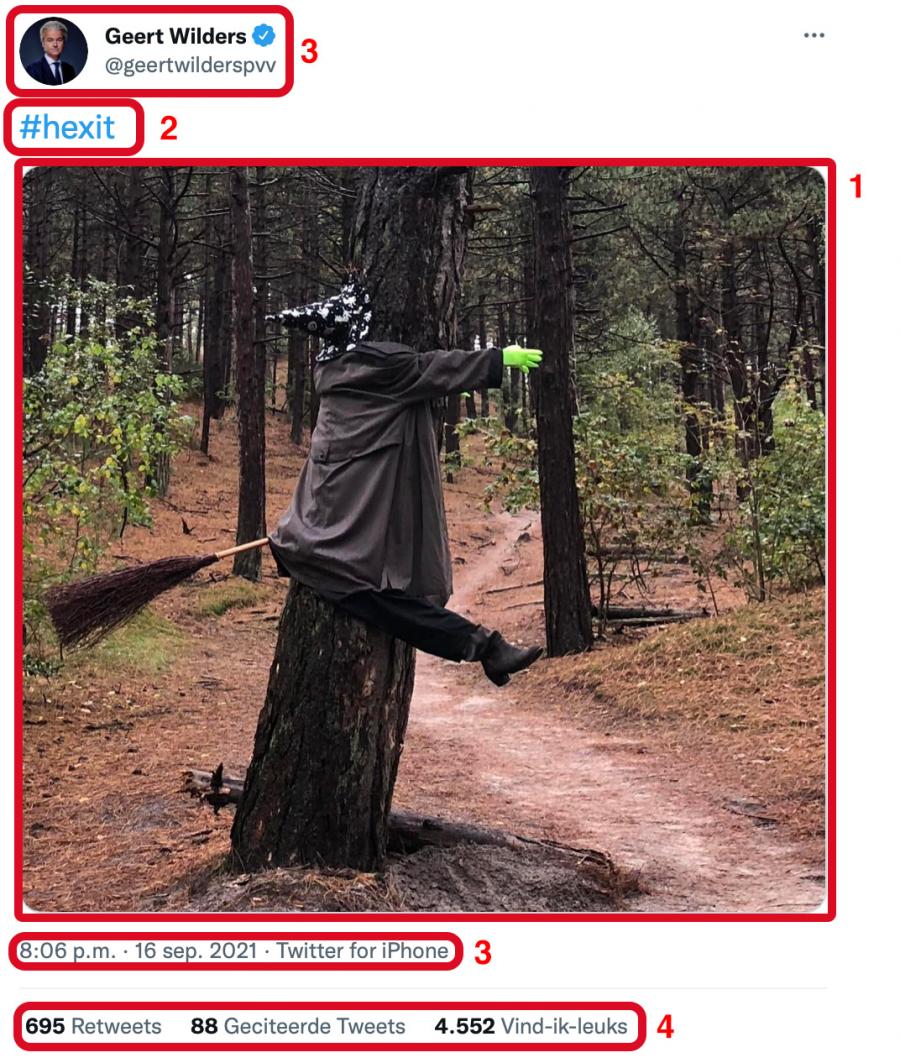
Figure 1: Four modes in the data: 1) image 2) caption 3) meta data 4) uptake metrics (screenshots, highlights are my own)
Historical meaning of witches
First, let’s look at the image in Figure 1. The broomstick, pointy hat, and green hands all signal the supposed identity of the puppet: a witch. Historically, witches have faced severe political prosecution because of their association with anti-sociality, evil, and even the Devil himself (Anderson, 2019 & Davies, 1999). Important to note is that medieval and renaissance-era witch hunts were “rooted in misogyny” (Hofstede, 2021). Being weak, lazy, unfaithful, untrustworthy, skilled in medicine, powerful, spiritual, or sexual could all be reasons for any woman to be burned at the stake (Hofstede, 2021).
Even though some experts argue that we should not overstate the misogynistic side of medieval witch hunts (Dekkers, 2021), it is precisely this narrative of misogyny that seems to intertextually ring through in the political discourse of the past decades. ‘Witch’ and its translation into other languages have often been used as derogatory terms to refer to women in powerful political positions. Margaret Thatcher, Hillary Clinton, and Angela Merkel have all been called ‘witches’ (Hofstede, 2021). In contrast, we see very few – if any – male politicians being called ‘witches’.
Wilders attempts to transfer the indexical value of witches onto Sigrid Kaag
It should be noted that since the 1960’s, “the feminist movement [has] adopted and rehabilitated the diabolical witch into the new Feminist Witch” (Harris, 2020). It is, however, unlikely that Wilders’ image refers to this more positive indexicality of the witch imagery. Instead, it conveys a sense of failure, incompetence, or clumsiness – though presented in a cartoonish manner. A skilled, competent witch, would not fly into a tree, one can assume.
‘Kaag the witch’
Through intertextuality, it quickly becomes clear that the witch in the image is supposed to represent Sigrid Kaag, the female leader of D66, a mainstream center-democratic political party. On June 29th, 2021, Wilders reacted to an opinion piece Kaag wrote wherein she condemns intimidating and offensive rhetoric by politicians with a one-word tweet: “Heks.” (Wilders, 2021). This reaction incited some news coverage and considerable social media uptake, which gave Wilders the momentum to start crafting a narrative of ‘Kaag the witch’. In doing so, Wilders attempts to transfer the indexical value of witches onto Sigrid Kaag.
The third mode in the data, the metadata, also gives strong hints that the depicted witch is supposed to represent Sigrid Kaag. On September 16th, 2021, Kaag resigned as Minister of Foreign Affairs because she failed to adequately evacuate Dutch civilians and personnel from Afghanistan during the Taliban take-over (Ministerie van Buitenlandse Zaken, 2021). According to the metadata, this is the very same day Geert Wilders posted the picture of the ‘incompetent’, ‘failing’ witch.
In addition, Kaag had already been depicted as a witch in the week leading up to Wilders’ tweet. On September 11th, 2021, Dutch political cartoonist Ruben L. Oppenheimer tweeted a cartoon where Kaag is depicted as flying towards the Twin Towers on a broomstick (see Figure 2 on the left). The towers have the face of the prime minister of the Netherlands, Mark Rutte, on them. This cartoon caused public commotion and was discussed in Dutch mainstream media, for instance in the talk-show Op1, where Oppenheimer was interviewed. In this interview, Oppenheimer explained: “I play with the witch comparison, but do it in a way that you can also see that the laughing Rutte, who thinks he is untouchable, is being attacked here” (Offringa, 2021).
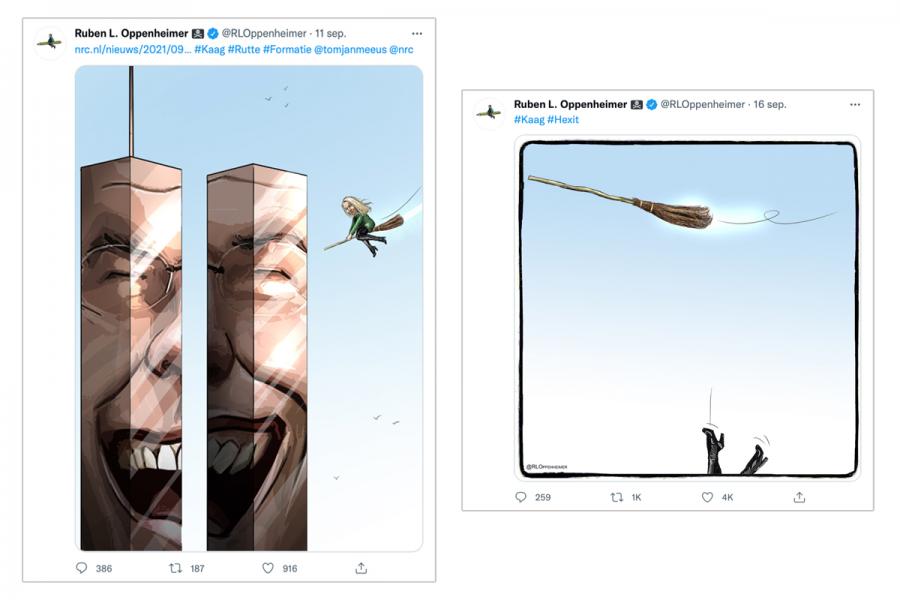
Figure 2: Cartoons by Ruben L. Oppenheimer
In this quote, Oppenheimer discloses that the cartoon refers to Rutte’s reputation as a politician that survives every scandal (Mudde, 2021). But that it also refers to a speech Kaag gave on September 6th, 2021, where she indirectly ‘attacked’ Rutte’s style of leadership and politics (NOS, 2021). Of course, the date of publication communicates intertextual meaning, making it (extra) clear the cartoon is meant to resemble the terrorist attack on the Twin Towers on September 11th, 2001.
Oppenheimer followed up on his cartoon (and the buzz that it generated) with another cartoon on September 16th, 2021, the day of Kaag’s resignation. In this cartoon, Kaag is drawn up as a witch who has fallen off her broomstick (see Figure 2 on the right). The narrative seems to be: the witch who was well on her way in attacking Rutte has failed and is now in trouble herself. Just like Wilders, Oppenheimer depicts Kaag as an incompetent witch, captioning the image with the hashtags #kaag and #hexit.
The buzz that Oppenheimer’s cartoons generated, offered Wilders the momentum to further elaborate his narrative of ‘Kaag the witch’
Notably, Oppenheimer tweeted his cartoon four minutes before Geert Wilders posted his #hexit-tweet (Oppenheimer posted at 8:02 PM, Wilders at 8:06 PM). Thus, it is possible that Wilders saw Oppenheimer’s tweet and decided to quickly entextualize the indexical meaning of the cartoon in a tweet of his own. Regardless of how intentional this entextualization was, the buzz that Oppenheimer’s cartoons generated, offered Wilders the momentum to further elaborate his narrative of ‘Kaag the witch’.
Hashtags
Wilders seems to further communicate his disapproval of Kaag with the caption he uses: “#hexit”, an agglutination of 'heks' and 'exit'. Agglutinations with the -exit suffix have made their way into the common vocabulary since the use of #Brexit was popularized in 2016 (Chotisarn et al., 2020). #Brexit quickly gave birth to local variants like #Frexit, #Oexit, and #Nexit (Lyons, 2020), the last of which was an official point of interest in the 2021 election manifesto of Wilders’ party PVV (Partij Voor de Vrijheid, 2021). All these hashtags denote the countries referenced by the hashtags leaving the EU. In other words: a smaller entity pulling out of (or exiting) a larger entity. By using the caption “#hexit” in combination with the image, Wilders seems to campaign for Sigrid Kaag – the failing witch – to leave a larger entity, presumably the (Dutch) political arena.
The hashtag feature is strongly embedded in the social media logic of Twitter. Hashtags “enable users to connect their individual tweets to large thematically linked bodies of tweets” (Blommaert, 2019). The use of a hashtag, therefore, indexes Wilders’ intention to insert himself into the discourse surrounding Kaag’s resignation. It also indexes that he is very specifically targeting an audience that is politically engaged. Since #hexit indexes Wilders’ resentment for Kaag, he could even be targeting a segment of the politically engaged audience that also feels resentment for the center-democratic politician.
Uptake
Just by looking at a handful of replies that Wilders received on his tweet, it already becomes very clear that he has certainly reached this Kaag-resenting audience. There are multiple reactions voicing agreement with Wilders (e.g. Figure 4), sometimes also using witch imagery and/or terminology (see Figure 3 and 4).
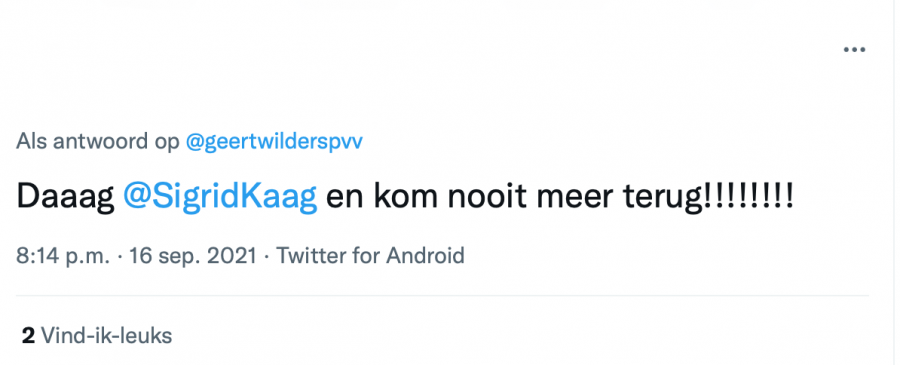
Figure 3: Tweet in reply to Geert Wilders' #hexit-tweet: "Byeee @SigridKaag and never come back!!!!!!!!" (screenshot)
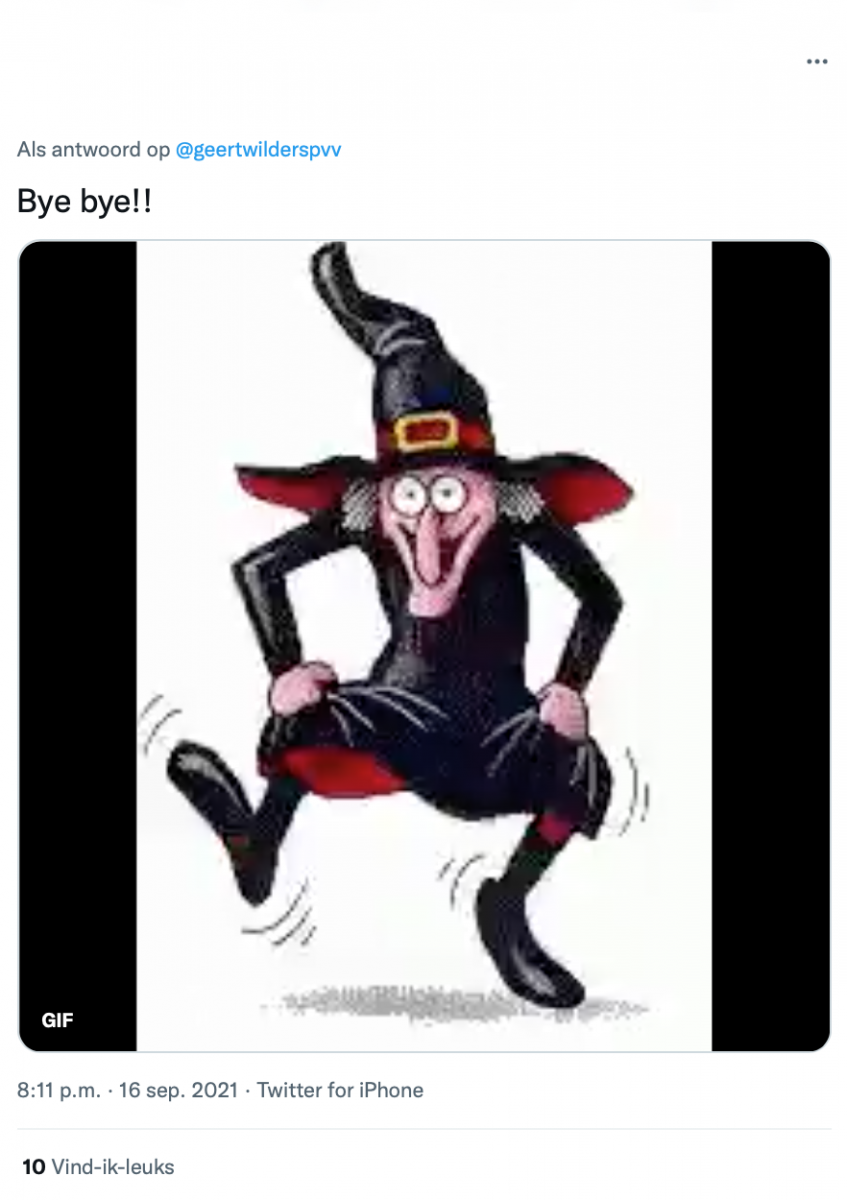
Figure 4: Tweet in reply to Geert Wilders' #hexit-tweet: "Bye Bye!!" (screenshot)
But not everybody replies in agreement. There are also replies voicing critique on Wilders, calling him “a cowardly phthisis dog” (Figure 5), and calling his tweet “a representative of the people unworthy”(Figure 6). One person even interprets Wilder’s tweet as indexing his inability to deal with strong women (Figure 7). Even though these replies are negative towards Wilders, they might actually play into his hands, considering social media logic (Van Dijck & Poell, 2013). By replying to his tweet, these Twitter users actually increase the reach of Wilder’s tweet, amplifying the very narrative of ‘Kaag the witch’ they oppose.
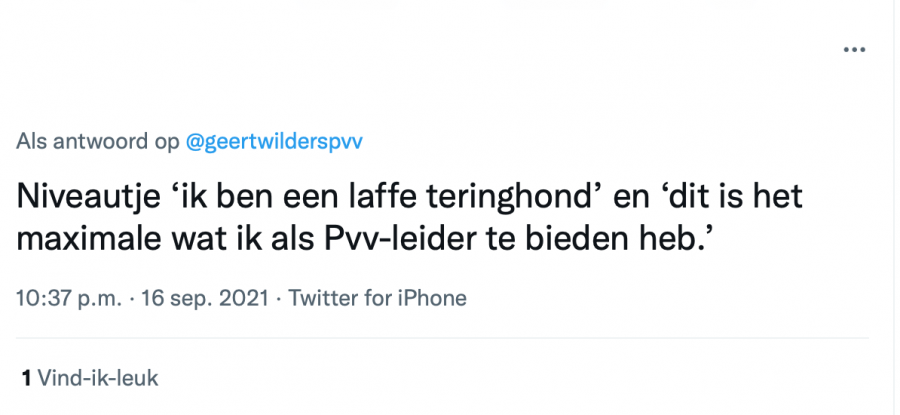
Figure 5: Tweet by in reply to Geert Wilders' #hexit-tweet: "The level of 'I am a cowardly phthisis dog' and 'this is the maximum I have to offer as a Pvv-leader.'" (screenshot)
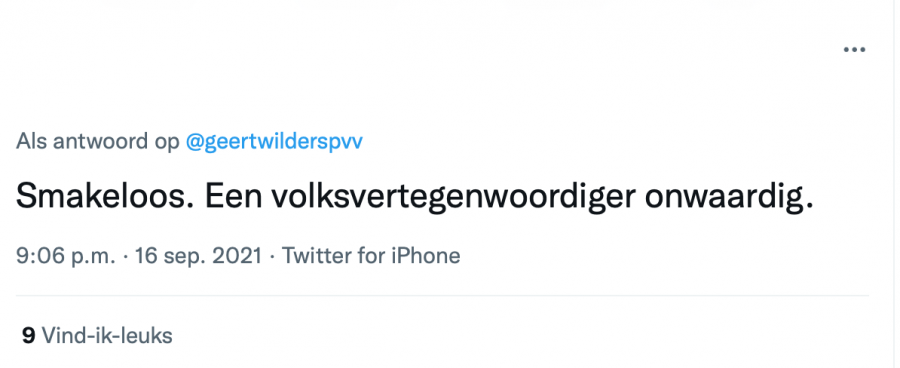
Figure 6: Tweet in reply to Geert Wilders' #hexit-tweet: "Tasteless. A representative of the people unworthy." (screenshot)
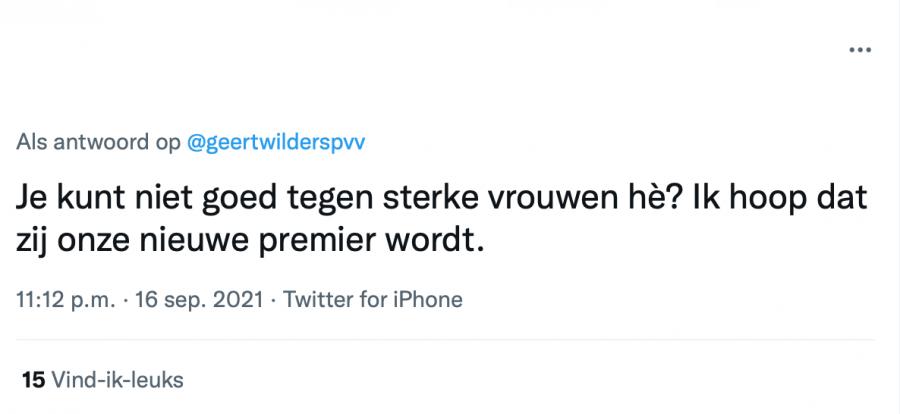
Figure 7: Tweet in reply to Geert Wilders' #hexit-tweet: "You can't handle strong women, right? I hope she'll become our new prime minister." (screenshot)
A new social meaning
This case study is not the only example of powerful women being called witches. But it does provide a telling insight into the way the word and imagery of the historical witch are used in Dutch political discourse specifically. By using discourse analysis, it becomes clear that the interplay between two prominent modes in Wilder's tweet – image and caption – is used by Wilders to link Sigrid Kaag to the imagined social identity of a witch in order to critique the female politician and campaign for her leaving the political arena.
In his tweet, Wilders entextualizes his previous witch-remark. He does so by deploying new semiotic resources (a hashtag, a picture) to transfer the indexical value of witches onto Kaag. He takes the historical, misogynistic, social meaning behind ‘witch’ and fuses this with the intertextual meaning he himself helped create by previously having called Kaag a witch. In doing so, Wilders gives new social, discursive meaning to witches. When referenced in Dutch political discourse, a witch isn’t just a powerful female politician, it is specifically Sigrid Kaag. And, regarding Oppenheimer’s cartoons and some of the replies to Wilders’ tweet, this new social meaning is already being adopted widely in Dutch political discourse.
References
Anderson, S. M. (2019). A Disarmament Program for Witches: The Prospective Politics of Antiwitchcraft, Postwarcraft, and Rebrandcraft in Sierra Leone. Cultural Anthropology, 34(2), 240–271.
Blommaert, J. (2019). Online with Garfinkel, Essays on social action in the online-offline nexus. Tilburg Papers in Culture Studies, 229, 82–95.
Chotisarn, N., Lu, J., Ma, L., Xu, J., Meng, L., Lin, B., Xu, Y., Luo, X., & Chen, W. (2020). Bubble storytelling with automated animation: a Brexit hashtag activism case study. Journal of Visualization, 24(1), 101–115.
Davies, O. (1999). Witchcraft, Magic and Culture 1736–1951. Manchester University Press.
Dekkers, G. (2021, 16 oktober). De heks was geen oerfeminist. de Volkskrant, Zaterdag 19-Zaterdag 21.
Diggit Magazine. (2020a, February 1). Indexicality.
Diggit Magazine. (2020b, February 13). Multimodal Discourse Analysis.
Diggit Magazine. (2020c, February 13). Intertextuality.
Harris, V. (2020). Witches on Surfboards: How Witch Media Has Ridden the Waves of Feminism. Cardinal Compositions, 4, 39–43.
Hofstede, B. (2021, 24 September). Heks, dat is hoe bange mannen vrouwen met macht noemen. De Correspondent.
Hulsman, L. (2021, 22 September). Bekijk hele roast Sigrid Kaag door Geert Wilders: “Te bang en te laf voor woorden”. Gids.
Lyons, K. (2020, 3 February). Frexit, Nexit or Oexit? Who will be next to leave the EU.
Ministerie van Buitenlandse Zaken. (2021, 16 september). Dutch minister of Foreign Affairs Sigrid Kaag steps down. News Item | Government.Nl.
Mudde, C. (2021, 21 March). Will “Teflon Mark” Rutte’s “good populism” bring the Dutch back to Europe? VoxEurop.
NOS. (2021, 6 september). Kaag toont ongenoegen over Rutte, “leiderschap is geen regelen en ritselen”.
Offringa, H. (2021, 14 september). Ruben Oppenheimer over de kritiek op zijn spotprenten: “Dat is mijn taak als cartoonist: het moet schuren”. Op1.
Partij Voor de Vrijheid. (2021). Het gaat om u, Verkiezingsprogramma 2021–2025.
PowNed. (2021, 29 June). Twitterende Geert tegen Kaag: “Heks”.
Reker, S. (2021, 14 September). Haar bezem pakken: Wilders die stil naar Oppenheimer verwijst. NOMEIS.
@RLOppenheimer. (2021a, September 11). Ruben L. Oppenheimer 🏴☠️ on [Tweet]. Twitter.
@RLOppenheimer. (2021b, September 16). Ruben L. Oppenheimer 🏴☠️ on [Tweet]. Twitter.
Saris, K., & Van de Ven, C. (2021, 3 March). Misogynie als politiek wapen. De Groene Amsterdammer.
Van Dijck, J., & Poell, T. (2013). Understanding Social Media Logic. Media and Communication, 1(1), 2–14.
Wilders, G. [@geertwilderspvv]. (2021, 16 September). #hexit [Tweet]. Twitter.
Wilders, G. [@geertwilderspvv]. (2021, 29 June). Heks. [Tweet]. Twitter.